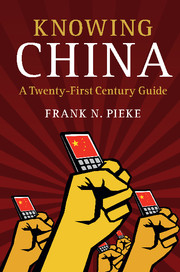Book contents
- Frontmatter
- Dedication
- Contents
- Preface
- Main Events in China, 1976–2015
- 1 Introduction: Knowing China
- 2 Why the Communist Party Will Not Fall from Power
- 3 China's Economy Will Continue to Grow, but Not Forever
- 4 Freedom without Universal Human Rights
- 5 From Empire to Nation, or Why Taiwan, Tibet and Xinjiang Will Not Be Given Independence
- 6 Not Just a Chinese Century
- 7 Conclusion: The Communist Party and China's Future
- Further Reading
- References
- Index
1 - Introduction: Knowing China
Published online by Cambridge University Press: 05 July 2016
- Frontmatter
- Dedication
- Contents
- Preface
- Main Events in China, 1976–2015
- 1 Introduction: Knowing China
- 2 Why the Communist Party Will Not Fall from Power
- 3 China's Economy Will Continue to Grow, but Not Forever
- 4 Freedom without Universal Human Rights
- 5 From Empire to Nation, or Why Taiwan, Tibet and Xinjiang Will Not Be Given Independence
- 6 Not Just a Chinese Century
- 7 Conclusion: The Communist Party and China's Future
- Further Reading
- References
- Index
Summary
Why China?
On the evening of 3 June 1989, I rode my bike down to Beijing's Tian'anmen Square, China's political and symbolic centre. I had done so virtually every day since students from Peking University almost two months earlier had posted a giant, black-and-white portrait in commemoration of Hu Yaobang at the Monument for Revolutionary Heroes there. Hu had been secretary general of the Chinese Communist Party (CCP) from 1982 to 1987, when paramount leader Deng Xiaoping sacked him for his support of widespread student demonstrations the year before. Hu continued to serve on the CCP's Politburo, but on 9 April 1989 he suddenly and unexpectedly collapsed from a heart attack during a meeting of that body, dying a few days later. The students’ commemorative act of political defiance on 15 April triggered an unprecedented national protest movement that involved at its peak on 17 May more than one million people in the capital alone, rocking the very foundations of CCP rule.
My visit to Tian'anmen Square on 3 June was different from my previous ones: I knew it would be my last. Heavily armed units of the People's Liberation Army had already entered Beijing from the Northwest, making their way to the city centre battling largely unarmed and unorganized groups of civilians. Later that evening, other, only lightly armed troops suddenly appeared in streets or intersections much closer to the square, confronting the public in an eerie, silent and ominous stand-off, without moving or trying to do anything. A few hours later, after midnight on 4 June, the army units that had entered the city from the Northwest reached, sealed off and cleared the square. How many students died then and there is still not known. Many more civilians had died during the army's march through the city. Communist Party rule had become a military occupation.
The Tian'anmen Movement – or June Fourth, as it is often known – impressed two conclusions upon me and many other people in China on that day. Despite ten years of reform, communist rule continued to be fundamentally violent, repressive and, in the final instance, based on the Party's control of the army. Furthermore, the Communist Party had lost whatever popular mandate it had and was on its last legs. Its demise would only be a matter of time.
- Type
- Chapter
- Information
- Knowing ChinaA Twenty-First Century Guide, pp. 1 - 14Publisher: Cambridge University PressPrint publication year: 2016

